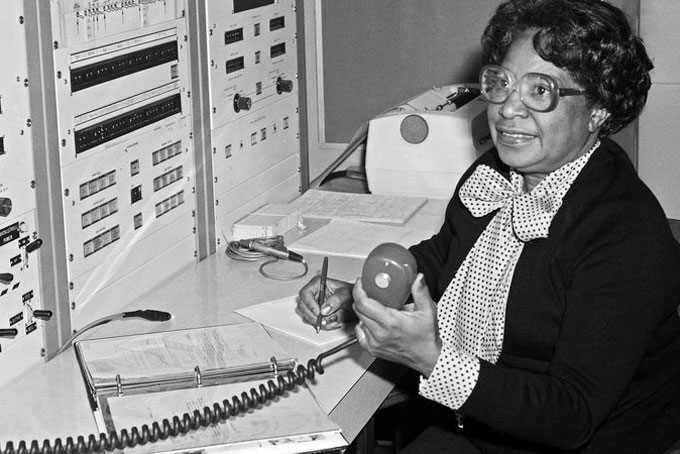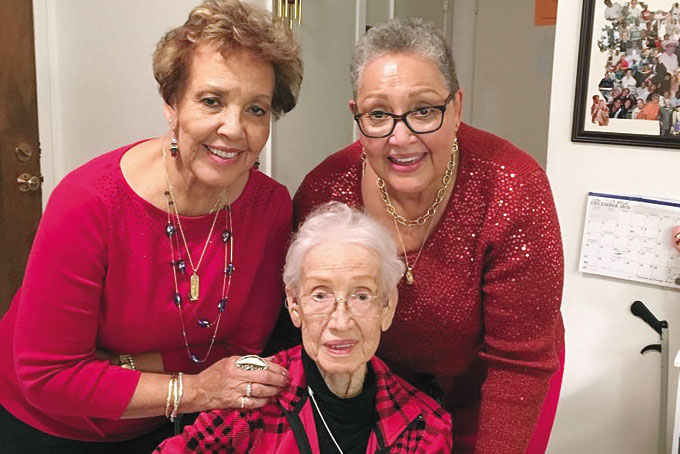
“I’m glad that I’m young enough still to be living and that they are, so they can look and see, ‘That’s who that is?” she said. “And they are as excited as I am.”
The story of the vital contribution to the U.S. space program by Katherine Johnson, Mary Jackson and Dorothy Vaughan.
The film, tells of the close-knit pool of Back women—dubbed “computers in skirts”—who were hired by NASA to work out the complex calculations necessary to launch space missions.

And it highlights what now seems the shocking practice of racial segregation.
Although the Black women were doing the same work as White women hired at the same time, they were cloistered away in their own separate office in the West Area of NASA’s Langley Research Center in Virginia, which resulted in them becoming known as The West Computers.

But thanks to their brilliance, women such as Mary Jackson—who fought prejudice to become NASA’s first Black space engineer—and Dorothy Vaughan, a genius computer programmer, were able to erode barriers of sex and race.
At the heart of the film lies the extraordinary story of Katherine Johnson, now 98.
Johnson’s daughter, Joylette Gobel Hylick, 76, said “Hers really is a hidden chapter in history.
“In a way it is impossible to tell the story of those famous astronauts without telling the story of these women too.”
Katherine had worked as a math teacher until 1953 when she heard that due to the post-war male labor shortage, jobs were being offered to Black female mathematicians at the National Advisory Committee for Aeronautics, which later became NASA.
She started work at Langley, before being selected for the flight research team—a department entirely staffed by White men.

The film shows how several times a day she would dash half a mile across the Langley campus in all weathers just to use the “colored” women’s toilet.
And originally she was expected to use a separate office coffee pot from her White colleagues.
But Katherine’s brilliant knowledge of analytical geometry gradually helped her make allies of her male bosses and she became a vital member of the space flight team.
She calculated the trajectory for America’s first space mission in 1961, manned by Alan Shepard, and the flight path that put Neil Armstrong on the moon in 1969.
John Glenn, the first American to orbit the earth, even called personally to ask for Katherine to double-check his landing co-ordinates, which had been calculated by NASA computers before he blasted off on his 1962 landmark mission.
She calculated the trajectory for America’s first space mission in 1961, manned by Alan Shepard, and the flight path that put Neil Armstrong on the moon in 1969.
Her daughter Joylette, herself a math graduate and systems engineer and programmer, said: “We lived in a segregated environment, it was real and all around us—water fountains, buses, schools.

“But my mother didn’t have time for it. I think she has always had a strong feeling of self-worth that was instilled by her father, who taught her she was no better but no worse than anybody else.
“She wouldn’t be intimidated or denied. But she didn’t do any of this for recognition, or to make a political statement. She did it for the challenge and to be at the cutting edge of science.”
In the midst of her vital work, Johnson was widowed at 38 and left to raise her three girls alone.
Joylette said: “We weren’t privileged kids. She did everything, she cooked, cleaned, made all our clothes.
“We used to watch the space launches together on television. I only wish I understood more then about what she did.”
Katherine Moore, her daughter, said she underestimated her mom’s job because the mathematician couldn’t tell anybody about her “top secret” work at NASA. It wasn’t until Moore was a freshman in college when she stumbled on more information in a newspaper article.
“I screamed out in the library, ‘That’s my mother!’ and I called her and said, ‘You never told me what you were doing,’ and she said, ‘It was my job,’” she said.
“She always saw beyond what other people were seeing, and it showed that in the movie, which I liked,” Moore said.
Today, Johnson is 98 and still living in Virginia. While she couldn’t physically visit the movie set, she made it to the premiere.

“Octavia Spencer was sitting right beside her and I had goosebumps because she’d reach over at certain scenes and hold her hand and pat her, and it was just an out-of-body experience to have your mother honored in that way,” Moore said.
In 2015, President Obama awarded Johnson the Presidential Medal of Freedom, the nation’s highest civilian honor. Soon a marker in West Virginia along route 64 will be renamed in her honor.
Similarly, Dorothy Vaughan’s six children had no idea of her role in the US space race until after she died at the age of 98 in 2008.
Her daughter Ann Hammond said “A lot of what she did was classified. We always knew we had an amazing mother, but we had no idea how amazing she was at work.”
Vaughan became the first Black supervisor at Langley when she was put in charge of the women in The West Computers.
Hammond, 81, said: “They were a tight group of women who worked together and my mother not only fought to get promoted, she un-selfishly fought for the others too.”
When Vaughan was scouted to head up Langley’s new computer lab she took the job only on the condition she could bring her staff with her as programmers—and as such the division became non-segregated.
Vaughan had grown up in poverty during the Depression but won a full university scholarship to study math and became an algebra teacher.
When she got a government job in 1944 she presumed it would just be a temporary wartime role.
Ann said: “The salary was double what she earned as a teacher but the hours were long—she often worked 24-hour shifts.
“So us six kids stayed with our grandmother for the next nine months while she worked 130 miles away and lived in a boarding house. When the job became permanent she moved us.”
Vaughan was widowed at 45 and Ann added: “She helped us with homework and insisted we went to university, though only one of us became a mathematician.
“We all did well but her grandchildren did even better—we have doctors, a pathologist, two dentists and a lawyer.”
(Information in this story came from AP and Wikipedia.)
Like us at https://www.facebook.com/pages/New-Pittsburgh-Courier/143866755628836?ref=hl
Follow @NewPghCourier on Twitter https://twitter.com/NewPghCourier